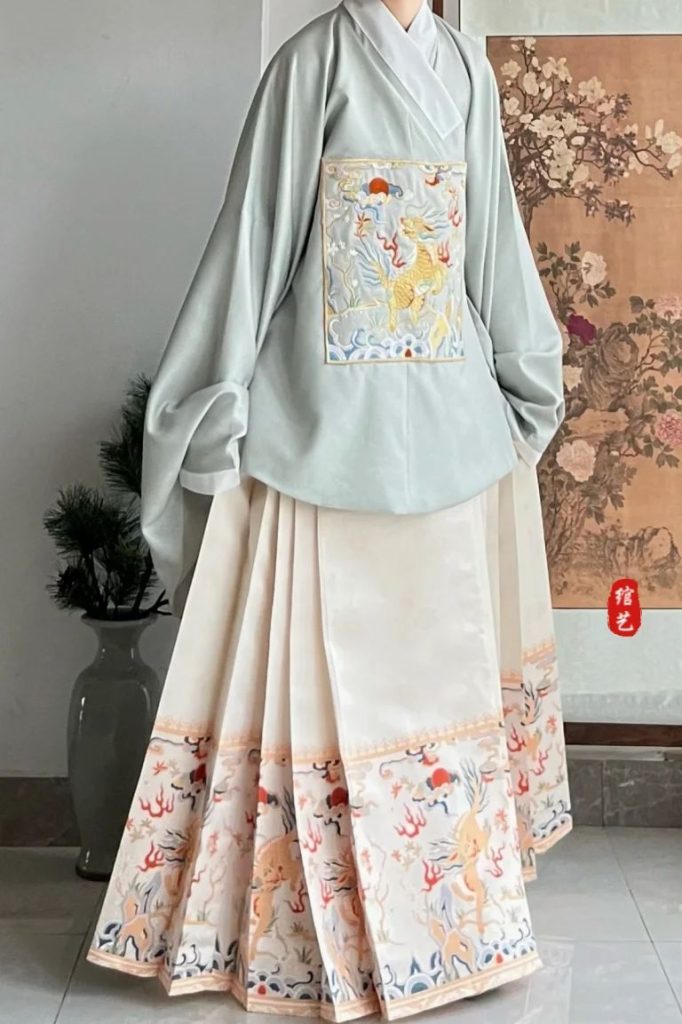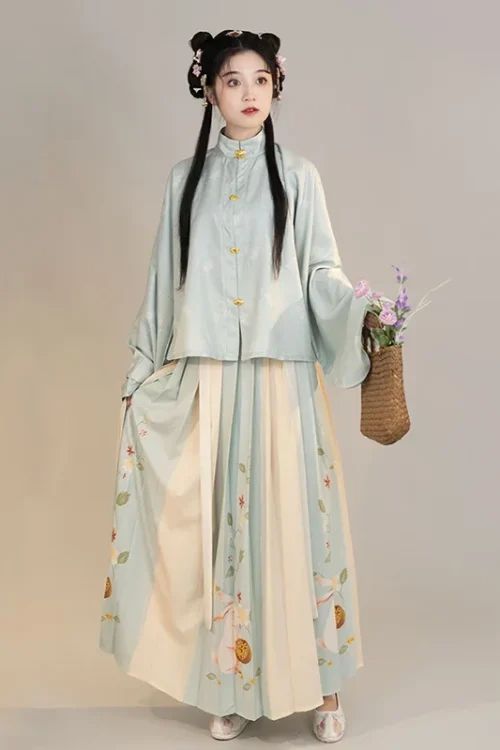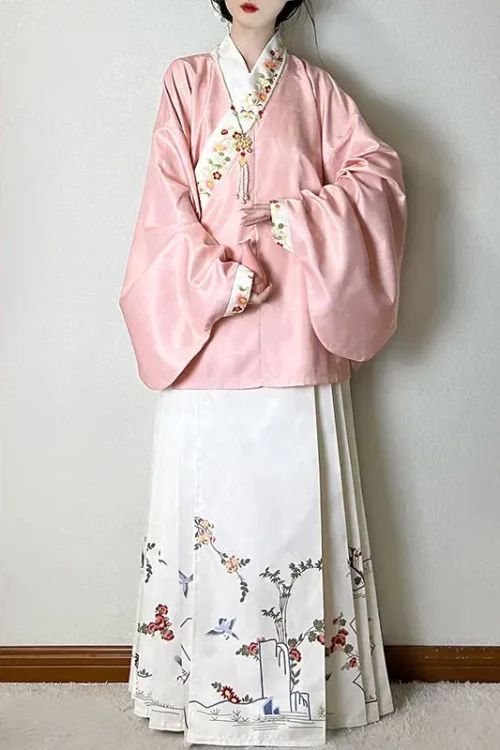The Phoenix Ruyi Pattern: Symbolism and Significance
The Ruyi pattern, an auspicious symbol in Chinese culture, is frequently featured on Hanfu, the traditional clothing of the Han Chinese. Among the various Ruyi patterns, the Phoenix Ruyi holds particular significance and symbolism.

The Phoenix in Chinese Mythology
The Phoenix, a mythical bird revered in Chinese mythology, represents prosperity, virtue, and harmony. Its graceful form and vibrant colors are often depicted in the Phoenix Ruyi pattern, which typically features a pair of phoenixes facing each other or a single phoenix in flight.
The Ruyi: A Symbol of Power and Fortune
The Ruyi itself, a curved object resembling a scepter, symbolizes power, authority, and good fortune. When combined with the Phoenix, the Phoenix Ruyi pattern becomes a potent symbol of auspiciousness and prosperity.
Phoenix Ruyi on Hanfu
In Hanfu, the Phoenix Ruyi pattern is often embroidered on the sleeves, hems, or collars of garments. It is believed to bring good luck, ward off evil spirits, and enhance the wearer’s social status. The pattern’s intricate details and vibrant colors add an element of elegance and sophistication to the Hanfu.
Cultural and Historical Significance
The Phoenix Ruyi pattern is not only a decorative element but also carries cultural and historical significance. It has been used in Chinese art and architecture for centuries, adorning palaces, temples, and other important structures. Its presence on Hanfu connects the wearer to a rich cultural heritage and evokes a sense of pride and tradition.
Influence Beyond China
Furthermore, the Phoenix Ruyi pattern has been adopted by other cultures in East Asia, including Japan and Korea. In these countries, it is known as the “Ho-o” or “Bong-hwang” pattern, respectively, and is similarly associated with good fortune and prosperity.
Conclusion: A Symbol of Auspiciousness and Heritage
In conclusion, the Phoenix Ruyi pattern on Hanfu is a symbol of auspiciousness, prosperity, and cultural heritage. Its intricate design and vibrant colors enhance the beauty of the garment while also conveying a deep cultural significance. The pattern serves as a reminder of the rich traditions and beliefs that have shaped Chinese culture for centuries.
The Dragon Ruyi Pattern: Power and Majesty
The Ruyi pattern, an auspicious symbol of good fortune and prosperity, is a ubiquitous motif in Chinese art and culture. It is often depicted on Hanfu, the traditional clothing of the Han Chinese, where it adorns robes, skirts, and accessories. Among the various types of Ruyi patterns, the Dragon Ruyi stands out as a symbol of power and majesty.

The Dragon in Chinese Culture
The Dragon Ruyi pattern combines the auspicious Ruyi cloud with the mythical dragon, a creature revered in Chinese culture as a symbol of strength, wisdom, and good fortune. The dragon is often depicted as a sinuous, serpentine creature with scales, claws, and a long, flowing beard. It is typically rendered in shades of gold, 绿化, or 红, colors associated with royalty and prosperity.
The Ruyi Cloud: A Symbol of Longevity
The Ruyi cloud, on the other hand, is a stylized representation of a mushroom-shaped cloud, a symbol of good luck and longevity. It is often depicted in 白色 or yellow, colors associated with purity and wealth. In the Dragon Ruyi pattern, the dragon is often shown emerging from or surrounded by Ruyi clouds, creating a dynamic and visually striking composition.
Dragon Ruyi on Hanfu
The Dragon Ruyi pattern is commonly found on the Hanfu of emperors, officials, and other high-ranking individuals. It is a symbol of their authority, power, and divine favor. The pattern is also used on ceremonial garments and objects, such as robes worn during important festivals and rituals.
Aesthetic Beauty of the Dragon Ruyi Pattern
In addition to its symbolic meaning, the Dragon Ruyi pattern is also appreciated for its aesthetic beauty. The intricate details and vibrant colors of the pattern create a visually stunning effect that adds a touch of elegance and sophistication to any Hanfu garment.
Conclusion: Symbolism and Tradition
The Dragon Ruyi pattern is a testament to the rich symbolism and artistic traditions of Chinese culture. It is a powerful and auspicious motif that embodies the values of power, majesty, and good fortune. As a decorative element on Hanfu, the Dragon Ruyi pattern not only enhances the beauty of the garment but also conveys a profound message about the wearer’s status and aspirations.
The Cloud Ruyi Pattern: Auspiciousness and Good Fortune
The Ruyi pattern, an auspicious symbol deeply rooted in Chinese culture, holds a prominent place in the adornment of Hanfu, the traditional clothing of the Han Chinese. Among the various forms of the Ruyi pattern, the Cloud Ruyi stands out as a particularly significant and visually striking motif.

The Significance of Clouds in Chinese Culture
The Cloud Ruyi pattern, as its name suggests, depicts stylized clouds, often arranged in a continuous, flowing pattern. Clouds, in Chinese mythology and folklore, symbolize good fortune, prosperity, and longevity. By incorporating the Cloud Ruyi pattern into Hanfu, wearers sought to invoke these auspicious qualities and attract blessings upon themselves.
Design and Aesthetic Appeal
The Cloud Ruyi pattern is characterized by its sinuous, cloud-like forms, which are typically rendered in a combination of curves and spirals. The pattern may be depicted in a variety of colors, but auspicious hues such as red, gold, and green are commonly used. The Cloud Ruyi pattern can be found on various Hanfu garments, including robes, skirts, and accessories.
Cultural Endurance of the Cloud Ruyi Pattern
The Cloud Ruyi pattern has been used in Hanfu for centuries, and its popularity continues to endure today. It is a testament to the enduring significance of auspicious symbols in Chinese culture and the enduring beauty of traditional Chinese aesthetics. Whether adorning a formal robe or a casual skirt, the Cloud Ruyi pattern remains a timeless and auspicious motif that embodies the hopes and aspirations of the Han Chinese people.
The Lotus Ruyi Pattern: Purity and Enlightenment
The Ruyi pattern, an emblem of good fortune and auspiciousness in Chinese culture, is a recurring motif in Hanfu, the traditional attire of the Han Chinese. Among the various Ruyi patterns, the Lotus Ruyi holds profound spiritual and cultural significance, symbolizing purity, enlightenment, and rebirth.

The Lotus in Chinese Spirituality
The Lotus flower, a revered symbol in Chinese culture, represents purity, spiritual awakening, and the continuous cycle of life, death, and rebirth. In Buddhism, the Lotus is a powerful symbol of enlightenment, as it blooms in muddy waters yet emerges clean and beautiful. This symbolism is reflected in the Lotus Ruyi pattern, which often features a stylized depiction of the lotus in various stages of bloom.
The Ruyi Scepter: An Emblem of Authority
The Lotus Ruyi pattern combines the symbolic lotus with the Ruyi scepter, a traditional Chinese symbol of power, authority, and good fortune. The result is a pattern that not only represents spiritual purity but also signifies the wearer’s moral integrity and virtuous character.
Lotus Ruyi in Hanfu Design
In Hanfu, the Lotus Ruyi pattern is often embroidered on formal garments, such as robes and skirts, as well as on accessories like sashes and belts. The pattern’s delicate and intricate design enhances the garment’s elegance while also conveying the wearer’s spiritual aspirations. The Lotus Ruyi pattern is particularly popular in ceremonial attire, where it symbolizes purity of heart and mind.
Cultural and Artistic Significance
The Lotus Ruyi pattern has a long history in Chinese art and culture, appearing in various forms of traditional artwork, from paintings and carvings to textiles and ceramics. Its presence on Hanfu connects the wearer to a rich tradition of spiritual symbolism and artistic expression, reflecting a deep appreciation for both beauty and meaning.
Conclusion: A Symbol of Purity and Virtue
The Lotus Ruyi pattern on Hanfu is more than just a decorative motif; it is a symbol of purity, spiritual enlightenment, and virtuous living. Its intricate design and profound symbolism make it a cherished element of traditional Chinese attire, embodying the cultural and spiritual values that have shaped Chinese society for centuries.
The Peony Ruyi Pattern: Prosperity and Honor
The Ruyi pattern, a symbol of auspiciousness and good fortune in Chinese culture, is a common feature in Hanfu, the traditional dress of the Han Chinese. Among the various Ruyi patterns, the Peony Ruyi is especially cherished for its association with prosperity, honor, and wealth.

The Peony in Chinese Culture
The Peony, often referred to as the “king of flowers” in China, symbolizes wealth, honor, and high social status. It is admired for its lush, full blossoms and vibrant colors, which represent prosperity and happiness. The Peony Ruyi pattern incorporates these elements, often depicting large, blooming peonies alongside the Ruyi scepter, creating a motif that is both visually striking and symbolically rich.
The Ruyi Scepter: A Sign of Good Fortune
In the Peony Ruyi pattern, the Ruyi scepter, a traditional Chinese symbol of power and good fortune, is often entwined with peony blossoms or surrounded by peony petals. This combination enhances the pattern’s meaning, associating the wearer with prosperity, honor, and the blessings of a prosperous life.
Peony Ruyi in Hanfu Embroidery
The Peony Ruyi pattern is a popular choice for Hanfu, particularly in garments intended for special occasions such as weddings, festivals, and other celebrations. The pattern’s rich symbolism of wealth and honor makes it an ideal choice for attire meant to convey good wishes and blessings. The Peony Ruyi is often embroidered in vibrant colors, such as red, gold, and pink, further enhancing its auspicious connotations.
Cultural Impact and Artistic Legacy
The Peony Ruyi pattern has been a significant motif in Chinese art and culture for centuries, appearing in paintings, embroidery, and decorative arts. Its use in Hanfu not only highlights the wearer’s appreciation for traditional Chinese aesthetics but also connects them to a broader cultural heritage that values prosperity, honor, and beauty.
Conclusion: A Symbol of Wealth and Status
The Peony Ruyi pattern on Hanfu is a symbol of prosperity, honor, and high social status. Its elegant design and rich symbolism make it a cherished motif in traditional Chinese clothing, reflecting the cultural values of wealth, happiness, and the blessings of a prosperous life.
Ruyi pattern is used in Hanfu in different types. You can have more understanding about pattern on Hanfu in our website: https://cheongsam.net/product-category/hanfu/. Hope you love the Hanfus with different style we provide!
